Sophia Human Biology (Sophia)
Ashford University
Page 2 out of 19 results
Sort by

-
Sophia Human Biology Milestone 3,(already passed) Latest Summer 2020.
- Other • 7 pages • 2022
-
- $12.49
- + learn more
Sophia Human Biology Milestone 3 You passed this Milestone 13 questions were answered correctly. 4 questions were answered incorrectly. 1 The is the part of the brain that controls voluntary movements, while the helps regulate activities that we do not control, including breathing and heartbeat. CONCEPT Hindbrain and Midbrain 2 Choose the correct order in which we experience taste/gustation. ● Pores of taste buds receive stimuli ● Taste receptors si...
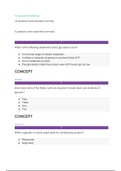
-
Sophia_Human_Biology_Milestone_1 - 5 (A GRADE) - Ashford University
- Package deal • 5 items • 2021
-
- $29.99
- + learn more
Sophia_Human_Biology_Milestone_1 (A GRADE) - Ashford University Sophia_Human_Biology_Milestone_2 (A GRADE) - Ashford University Sophia_Human_Biology_Milestone_3 (A GRADE) - Ashford University Sophia_Human_Biology_Milestone_4 (A GRADE) - Ashford University Sophia_Human_Biology_Milestone_5 (A GRADE) - Ashford University
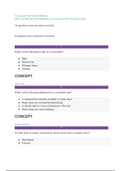
-
Sophia_Human_Biology_Practice_Milestone_1 (A GRADE) - Ashford University | Sophia_Human_Biology_Practice_Milestone_1 (A GRADE)
- Exam (elaborations) • 8 pages • 2021
-
- $12.49
- + learn more
You passed this Practice Milestone. When you take the actual Milestone, you must score 50% or higher to pass. 15 questions were answered correctly. 8 questions were answered incorrectly. 1 Which of the following is part of a nucleotide? ● RNA ● Ribosomes ● Nitrogen base ● Cytosol CONCEPT Nucleic Acids 2 Which of the following statements is a verifiable fact? ● A restaurant's business is better on rainy days. ● Rainy days are somewhat depressing. ● A nearby park is ...
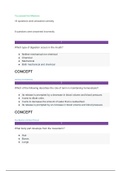
-
Sophia_Human_Biology_Milestone_5 (A GRADE) - Ashford University | Sophia_Human_Biology_Milestone_5 (A GRADE)
- Exam (elaborations) • 9 pages • 2021
- Available in package deal
-
- $11.99
- + learn more
You passed this Milestone 18 questions were answered correctly. 8 questions were answered incorrectly. 1 Which type of digestion occurs in the mouth? ● Neither mechanical nor chemical ● Chemical ● Mechanical ● Both mechanical and chemical CONCEPT Chewing and Swallowing 2 Which of the following describes the role of renin in maintaining homeostasis? ● Its release is prompted by a decrease in blood volume and blood pressure. ● It acts to dilute urine. ● It acts to decr...
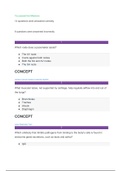
-
Sophia_Human_Biology_Milestone_4 (A GRADE) - Ashford University | Sophia_Human_Biology_Milestone_4 (A GRADE)
- Exam (elaborations) • 7 pages • 2021
- Available in package deal
-
- $11.99
- + learn more
You passed this Milestone 14 questions were answered correctly. 6 questions were answered incorrectly. 1 Which node does a pacemaker assist? ● The AV node ● It acts against both nodes ● Both the SA and AV nodes ● The SA node CONCEPT Cardiac Cycle and Cardiac Conduction System 2 What muscular tubes, not supported by cartilage, help regulate airflow into and out of the lungs? ● Bronchioles ● Trachea ● Alveoli ● Diaphragm CONCEPT Lower Respiratory Tract 3 Which ...
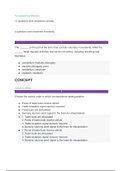
-
Sophia_Human_Biology_Milestone_3 (A GRADE) - Ashford University | Sophia_Human_Biology_Milestone_3 (A GRADE)
- Exam (elaborations) • 7 pages • 2021
- Available in package deal
-
- $11.99
- + learn more
You passed this Milestone 13 questions were answered correctly. 4 questions were answered incorrectly. 1 The _______ is the part of the brain that controls voluntary movements, while the ______ helps regulate activities that we do not control, including breathing and heartbeat. ● cerebellum; medulla oblongata ● medulla oblongata; pons ● cerebellum; cerebrum ● midbrain; hindbrain CONCEPT Hindbrain and Midbrain 2 Choose the correct order in which we experience taste/gustation...
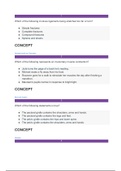
-
Sophia_Human_Biology_Milestone_2 (A GRADE) - Ashford University | Sophia_Human_Biology_Milestone_2 (A GRADE)
- Exam (elaborations) • 6 pages • 2021
- Available in package deal
-
- $11.99
- + learn more
1 Which of the following involves ligaments being stretched too far or torn? ● Simple fractures ● Complete fractures ● Compound fractures ● Sprains and strains CONCEPT Skeletal Health and Disorders 2 Which of the following represents an involuntary muscle contraction? ● Jude turns the page of a book he's reading. ● Michael swats a fly away from his food. ● Roxanne goes for a walk to stimulate her muscles the day after finishing a marathon. ● Maureen's pupils narro...

-
Sophia_Human_Biology_Milestone_1 (A GRADE) - Ashford University | Sophia_Human_Biology_Milestone_1 (A GRADE)
- Exam (elaborations) • 8 pages • 2021
- Available in package deal
-
- $12.99
- + learn more
You passed this Milestone 18 questions were answered correctly. 5 questions were answered incorrectly. 1 Which of the following statements about glycolysis is true? ● It is the last stage of cellular respiration. ● It utilizes a molecule of glucose to produce three ATP. ● It is an anaerobic process. ● Phosphorylation halts the process when ATP levels get too low. CONCEPT Glycolysis 2 How many turns of the Krebs cycle are required to break down one molecule of glucose? ● F...
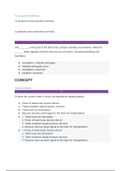
-
Sophia Human Biology Milestone 3,(already passed) Latest Summer 2020.
- Exam (elaborations) • 7 pages • 2021
-
- $13.49
- + learn more
Sophia Human Biology Milestone 3. You passed this Milestone 13 questions were answered correctly. 4 questions were answered incorrectly. 1 The _______ is the part of the brain that controls voluntary movements, while the ______ helps regulate activities that we do not control, including breathing and heartbeat. ● cerebellum; medulla oblongata ● medulla oblongata; pons ● cerebellum; cerebrum ● midbrain; hindbrain CONCEPT Hindbrain and Midbrain 2 Choose the correct order in which we experi...

Study stress? For sellers on Stuvia, these are actually golden times. KA-CHING! Earn from your study resources too and start uploading now. Discover all about earning on Stuvia


